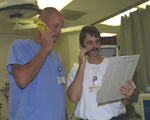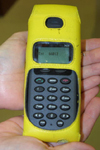Phones connect people, enhance patient care
by Cindy AbolePublic Relations
The ability to quickly locate nurses and medical staff during an emergency and communicate information can be a challenge that can affect patient care within medical environments.
 Emergency
Services clinical associate Michael Norris, left, and clinical nurse leader
Chip Turner, communicate with other medical staff using the wireless phones.
Emergency
Services clinical associate Michael Norris, left, and clinical nurse leader
Chip Turner, communicate with other medical staff using the wireless phones.
At MUSC, nurses, technicians, and medical staff embraced a new device that may resolve these issues and improve communications among staff in today’s busy health care settings.
In preparing the medical center for the millennium, clinical leaders searched for a state-of-the-art communication product that would complement its wireless communication network as a way to improve voice communications among staff. The result was the installation of a Medical Centerwide 802-11B wireless, Ethernet network.
In 2001, hospital administration formed a wireless communications task force from Hospital Communications, CCIT (University Communications and Network Systems Teams, clinical areas and staff research possible solutions, vendors and grade phones on software based on mobility signal and coverage, ease of use, reliability, and battery life, administration and other capabilities. They even conducted a visit to Carolinas Hospital System in Florence to observe products in use.
 The
new VolP wireless phone are in the hands of most nursing staff.
The
new VolP wireless phone are in the hands of most nursing staff.
At the time, 900-MHz wireless phones dominated the market and were among the first models tested by staff. But like most examples of evolving technology, a newer, improved digital model introduced by Ayava, was ultimately selected. Avaya is the manufacturer of the campus' telephone system, making it easy to integrate the wireless VoIP.
“In a way, we’ve waited for this technology to help develop the next-generation phone and software that would give us a leading edge in our needs while complying with the hospital’s new quiet environment policy and HIPAA standards on patient confidentiality,” said Laurie Zone-Smith, R.N., clinical administration and group member.
The wireless phones won't replace the hospital’s paging system, instead they are viewed as an additional tool to enhance staff communications, Zone-Smith said. The hospital’s Simon pagers are still an effective way to communicate with physicians and house staff, she said.
“In health care, it’s part of our nature to communicate with pagers,” Zone-Smith said. “We cannot eliminate the pager as the sole form of staff communications but we can manage the types of pages by providing alternative tools to communicate different types of information.”
About the size of a standard cordless phone, the phones are digital and can be programmed like standard hard wired digital phones featuring functions such as multiple number display, call hold, forward, transfer, caller ID, conference calling, and other voice mail options. They also are easily identified by their sun-yellow case.
CCIT’s Vince Dibble and his staff integrate the telephone system with the wireless network, assuring connectivity throughout campus. Dibble's team worked with Hospital Communications in acquiring the phones and provides the support and administration of the new phones. His network team performed a site survey to determine access points or wireless antennas. Currently, there are 130 access points located around medical center corridors.
“This project allowed us to enhance our network infrastructure,” said Dibble. “We’re providing a network solution that minimizes the use of the unit phone's overhead paging, improve patient care and at the same time expand our wireless data network. ”
The phones were also tested in Emergency Services, the 2 East Joint Replacement Short-Stay Unit, and among the hospital service coordinators (HSC) staff.
“The wireless phones offer a unique opportunity for improving communi-cations in nursing care,” said Julie Adam, R.N., nurse manager for the hospital options pool, staffing office and hospital service coordinators. Adam is also interim nurse manager for surgery, trauma, and neurological ICU.
“Unit secretaries may not always be at the center of activity within patient care areas,” she said. “There are times when nurses are too busy to answer the phone, and the calls roll back to the unit desk or staff can’t be located. Having these phones allows our nursing staff to respond immediately and conduct their jobs more effectively.”
Nurse Stephanie Chomos and the hospital service coordinator (HSC) staff rely heavily on the new wireless phones. After business hours and on weekends, the adult and pediatric HSCs respond to a multitude of patient care issues and administrative needs throughout the medical center. Carrying a pager and wireless phone, an HSC covering adult services can receive up to 50 pages or more per eight-hour shift.
“The phones are great,” Chomos said. “There’s less time spent chasing people down or finding an available phone to use. Now, I can just phone in.”
The phones can literally be a lifesaver in emergency situations. During code alerts, staff can be located immediately to respond to physician and staff needs, and information can be shared in a private, person-to-person conver-sation instead of through an overhead paging system or intercom.
Emergency Services nurse manager Ellen Ruja helped coordinate details for the first pilot study. Ruja was a longtime advocate of the wireless phones since her first introduction to the technology in the mid-1990s, while working in the Med-Surgical Step-down unit at Denver Health Medical Center.
“I was excited to learn that Emergency Services would be among the first areas testing these phones,” Ruja said. “In our area of medicine, communication is vital among the staff. Having these phones definitely made our jobs easier.”
During their busiest shifts, each of the nine nurses, four technicians, two physicians and physicians assistant carries a phone. Since the study, phones were distributed to Emergency Services’ guest services greeter and security staffer to ensure maximum coverage.
“The phones help people stay in touch, whether they are within the department or around the hospital, outside assisting an incoming patient, or having lunch,” Ruja said. “It is a wireless system that works well within our needs.”
Despite minor issues with spotty coverage and other functions, the phones were a hit among staff. Problems can be reported and responded to effectively through CCIT’s help desk, so staff can provide follow-up. Problems can be reported to University Communications at 792-9980.
Friday, Aug. 13, 2004
Catalyst Online is published weekly, updated
as needed and improved from time to time by the MUSC Office of Public Relations
for the faculty, employees and students of the Medical University of South
Carolina. Catalyst Online editor, Kim Draughn, can be reached at 792-4107
or by email, catalyst@musc.edu. Editorial copy can be submitted to Catalyst
Online and to The Catalyst in print by fax, 792-6723, or by email to petersnd@musc.edu
or catalyst@musc.edu. To place an ad in The Catalyst hardcopy, call Community
Press at 849-1778.